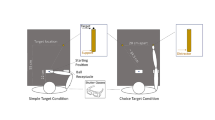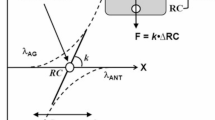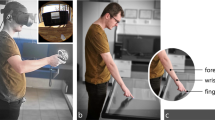Abstract
Two types of finger interaction are characterized by positive co-variation (enslaving) or negative co-variation (error compensation) of finger forces. Enslaving reflects mechanical and neural connections among fingers, while error compensation results from synergic control of fingers to stabilize their net output. Involuntary and voluntary force changes by a finger were used to explore these patterns. We hypothesized that synergic mechanisms will dominate during involuntary force changes, while enslaving will dominate during voluntary finger force changes. Subjects pressed with all four fingers to match a target force that was 10% of their maximum voluntary contraction (MVC). One of the fingers was unexpectedly raised 5.0 mm at a speed of 30.0 mm/s. During finger raising the subject was instructed “not to intervene voluntarily”. After the finger was passively lifted and a new steady-state achieved, subjects pressed down with the lifted finger, producing a pulse of force voluntarily. The data were analyzed in terms of finger forces and finger modes (hypothetical commands to fingers reflecting their intended involvement). The target finger showed an increase in force during both phases. In the involuntary phase, the target finger force changes ranged between 10.71 ± 1.89% MVC (I-finger) and 16.60 ± 2.26% MVC (L-finger). Generally, non-target fingers displayed a force decrease with a maximum amplitude of −1.49 ± 0.43% MVC (L-finger). Thus, during the involuntary phase, error compensation was observed—non-lifted fingers showed a decrease in force (as well as in mode magnitude). During the voluntary phase, enslaving was observed—non-target fingers showed an increase in force and only minor changes in mode magnitude. The average change in force of non-target fingers ranged from 21.83 ± 4.47% MVC for R-finger (M-finger task) to 0.71 ± 1.10% MVC for L-finger (I-finger task). The average change in mode of non-target fingers was between −7.34 ± 19.27% MVC for R-finger (L-finger task) and 7.10 ± 1.38% MVC for M-finger (I-finger task). We discuss a range of factors affecting force changes, from purely mechanical effects of finger passive lifting to neural synergic adjustments of commands to individual fingers. The data fit a recently suggested scheme that merges the equilibrium-point hypothesis (control with referent configurations) with the idea of hierarchical synergic control of multi-element systems.





Similar content being viewed by others
References
Arbib MA, Iberall T, Lyons D (1985) Coordinated control programs for movements of the hand. In: Goodwin AW, Darian-Smith I (eds) Hand function and the neocortex. Berlin, Springer Verlag
Benjamin M, Kaiser E, Milz S (2008) Structure-function relationships in tendons: a review. J Anatomy 212:211–228
Butler TJ, Kilbreath SL, Gorman RB, Gandevia SC (2005). Selective recruitment of single motor units in human flexor digitorum superficialis muscle during flexion of individual fingers. J Physiol 564:301–309
Danion F, Schoner G, Latash ML, Li S, Scholz JP, Zatsiorsky VM (2003) A mode hypothesis for finger interaction during multi-finger force-production tasks. Biol Cybern 88:91–98
Fahrer M (1981) Interdependent and independent actions of the fingers. In: Tubiana R (ed) The hand. Saunders, Philadelphia
Feldman AG (1966) Functional tuning of the nervous system with control of movement or maintenance of a steady posture. II. Controllable parameters of the muscle. Biophysics 11:565–578
Feldman AG (1986) Once more on the equilibrium-point hypothesis (λ-model) for motor control. J Mot Behav 18:17–54
Feldman AG, Levin MF (1995) Positional frames of reference in motor control: their origin and use. Behav Brain Sci 18:723–806
Gelfand IM, Latash ML (1998) On the problem of adequate language in motor control. Mot Control 2:306–313
Gorniak S, Zatsiorsky VM, Latash ML (2007) Hierarchies of synergies: an example of the two-hand, multi-finger tasks. Exp Brain Res 179:167–180
Keen DA, Fuglevand AJ (2004) Distribution of motor unit force in human extensor digitorum assessed by spike-triggered averaging and intraneural microstimulation. J Neurophysiol 91:2515–2523
Kilbreath SL, Gandevia SC (1994) Limited independent flexion of the thumb and fingers in human subjects. J Physiol 479:487–497
Klous M, Danna-dos-Santos A, Latash ML (2010) Multi-muscle synergies in a dual postural task: evidence for the principle of superposition. Exp Brain Res 202:457–471
Latash ML (2008) Synergy. Oxford University Press, New York
Latash ML (2010a) Motor control: in search of physics of the living systems. J Hum Kinet 24:7–18
Latash ML (2010b) Motor synergies and the equilibrium-point hypothesis. Mot Control 14:294–322
Latash ML, Li ZM, Zatsiorsky VM (1998) A principle of error compensation studied within a task of force production by a redundant set of fingers. Exp Brain Res 122:131–138
Latash ML, Scholz JF, Danion F, Schoner G (2001) Structure of motor variability in marginally redundant multifinger force production tasks. Exp Brain Res 141:153–165
Latash ML, Scholz JP, Schöner G (2002) Motor control strategies revealed in the structure of motor variability. Exerc Sport Sci Rev 30:26–31
Latash ML, Scholz JP, Schöner G (2007) Toward a new theory of motor synergies. Mot Control 11:276–308
Latash ML, Friedman J, Kim SW, Feldman AG, Zatsiorsky VM (2010) Prehension synergies and control with referent hand configurations. Exp Brain Res 202:213–229
Leijnse JNAL (1997) Measuring force transfers in the deep flexors of the musician’s hand: theoretical analysis, clinical examples. J Biomech 30:873–882
Li ZM, Latash ML, Zatsiorsky VM (1998) Force sharing among fingers as a model of the redundancy problem. Exp Brain Res 119:276–286
Li S, Latash ML, Zatsiorsky VM (2003) Finger interaction during multi-finger tasks involving finger addition and removal. Exp Brain Res 150:230–236
Liddell EGT, Sherrington CS (1924) Reflexes in response to stretch (myotatic reflexes). Proc Roy Soc Lond B 96:212–242
Magnusson SP (1998) Passive properties of human skeletal muscle during stretch maneuvers. A review. Scand J Med Sci Sport 8:65–77
Martin JR, Latash ML, Zatsiorsky VM (2009) Interaction of finger enslaving and error compensation in multiple finger force production. Exp Brain Res 192:293–298
Martin JR, Budgeon MK, Latash ML, Zatsiorsky VM (2010) Stabilization of the total force in multi-finger pressing tasks studied with the ‘inverse piano’ technique. Hum Move Sci (in press)
Matthews PBC (1959) The dependence of tension upon extension in the stretch reflex of the soleus of the decerebrate cat. J Physiol 47:521–546
McNulty PA, Cresswell AG (2004) Recruitment of single human low-threshold motor units with increasing loads at different muscle lengths. J Electromyography Kinesiol 14:369–377
Rack PMH, Westbury DR (1969) The effects of length and stimulus rate on tension in the isometric cat soleus muscle. J Physiol 204:443–460
Rathelot JA, Strick PL (2006) Muscle representation in the macaque motor cortex: an anatomical perspective. PNAS 103:8257–8262
Sanes JN, Donoghue JP, Thangaraj V, Edelman RR, Warach S (1995) Shared neural substrates controlling hand movements in human motor cortex. Science 268:1775–1777
Schieber MH (1995) Muscular production of individuated finger movements: the roles of extrinsic finger muscles. J Neuroscience 15:284–297
Schieber MH, Hibbard LS (1993) How somatotopic is the motor cortex hand area. Science 261:489–492
Scholz JP, Danion F, Latash ML, Schoner G (2002) Understanding finger coordination through analysis of the structure of force variability. Biol Cybern 86:29–39
Shapkova EY, Shapkova AL, Goodman SR, Zatsiorsky VM, Latash ML (2008) Do synergies decrease force variability? A study of single-finger and multi-finger force production. Exp Brain Res 188:411–425
Shim JK, Park J, Zatsiorsky VM, Latash ML (2006) Adjustments of prehension synergies in response to self-triggered and experimenter-triggered load and torque perturbations. Exp Brain Res 175:641–653
Vigouroux L, Ferry M, Colloud F, Paclet F, Cahouet V, Quaine F (2008) Is the principle of minimization of secondary moments validated during various fingertip force production conditions? Hum Mov Sci 27:396–407
Zatsiorsky VM, Li ZM, Latash ML (1998) Coordinated force production in multi-finger tasks: finger interaction and neural network modeling. Biol Cybern 79:139–150
Zatsiorsky VM, Li ZM, Latash ML (2000) Enslaving effects in multi-finger force production. Exp Brain Res 131:187–195
Zatsiorsky VM, Gregory RW, Latash ML (2002) Force and torque production in static multifinger prehension: biomechanics and control. II. Control. Biol Cybern 87:40–49
Zhang W, Scholz JP, Zatsiorsky VM, Latash ML (2008) What do synergies do? Effects of secondary constraints on multi-digit synergies in accurate force-production tasks. J Neurophys 99:500–513
Acknowledgments
The study was in part supported by NIH grants AG-018751, NS-035032, and AR-048563.
Author information
Authors and Affiliations
Corresponding author
Rights and permissions
About this article
Cite this article
Martin, J.R., Zatsiorsky, V.M. & Latash, M.L. Multi-finger interaction during involuntary and voluntary single finger force changes. Exp Brain Res 208, 423–435 (2011). https://doi.org/10.1007/s00221-010-2492-z
Received:
Accepted:
Published:
Issue Date:
DOI: https://doi.org/10.1007/s00221-010-2492-z




